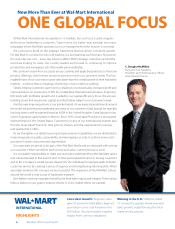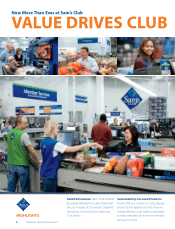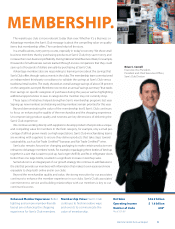Walmart 2009 Annual Report Download - page 18
Download and view the complete annual report
Please find page 18 of the 2009 Walmart annual report below. You can navigate through the pages in the report by either clicking on the pages listed below, or by using the keyword search tool below to find specific information within the annual report.
16 Wal-Mart 2009 Annual Report
Management’s Discussion and Analysis of Financial
Condition and Results of Operations
The Retail Industry
We operate in the highly competitive retail industry in both the
United States and the countries we serve internationally. We face
strong sales competition from other discount, department, drug,
variety and specialty stores, warehouse clubs, and supermarkets,
many of which are national, regional or international chains, as well
as internet-based retailers and catalog businesses. We compete with
a number of companies for prime retail site locations, as well as in
attracting and retaining quality employees (whom we call “associ-
ates”). We, along with other retail companies, are in uenced by a
number of factors including, but not limited to: general economic
conditions, cost of goods, consumer disposable income, consumer
debt levels and buying patterns, consumer credit availability, interest
rates, customer preferences, unemployment, labor costs, in ation,
currency exchange uctuations, fuel and energy prices, weather pat-
terns, catastrophic events, competitive pressures and insurance costs.
Further information on risks to our Company can be located in “Item
1A. Risk Factors” in our Annual Report on Form 10-K for the scal year
ended January 31, 2009.
Company Performance Metrics
Management uses a number of metrics to assess the Company’s
performance including:
• Total sales;
• Comparable store sales;
• Operating income;
• Diluted income per share from continuing operations;
• Return on investment; and
• Free cash ow.
Comparable Store Sales
Fiscal Year Ended January 31,
2009 2008 2007
Walmart U.S. 3.2% 1.0% 1.9%
Sam’s Club (1) 4.8% 4.9% 2.5%
Total U.S. 3.5% 1.6% 2.0%
(1) Sam’s Club comparable club sales include fuel. Fuel sales had a positive impact
of 1.2 and 0.7 percentage points in scal years 2009 and 2008, respectively, and
negative 0.4 percentage points on comparable club sales in scal 2007.
Our total net sales increased by 7.2% and 8.6% in scal 2009 and 2008
when compared to the previous scal year. Those increases resulted
from our global store expansion programs, comparable store sales
increases and acquisitions.
Comparable store sales is a measure which indicates the performance
of our existing stores by measuring the growth in sales for such stores
for a particular period over the corresponding period in the prior year.
Comparable store sales in the United States increased 3.5% in scal
2009 and 1.6% in scal 2008. Comparable store sales in the United
States in scal 2009 were higher than scal 2008 due to an increase
in customer tra c as well as an increase in average transaction size
per customer. As we continue to add new stores in the United States,
we do so with an understanding that additional stores may take sales
away from existing units. During scal 2008, in connection with our
revisions to our capital e ciency model, we revised our methodology
for calculating the negative impact of new stores on comparable
store sales. Using our new methodology, we estimate the negative
impact on comparable store sales as a result of opening new stores
was approximately 1.1% in scal 2009 and 1.5% in scal 2008. With
our planned reduction in new store growth, we expect the impact
of new stores on comparable store sales to decline over time.
During scal 2009, foreign currency exchange rates had a $2.3 billion
unfavorable impact on the International segment’s net sales. Despite
this unfavorable impact, the International segment’s net sales as a
percentage of total Company net sales increased slightly. Although
movements in foreign currency exchange rates cannot reasonably
be predicted, volatility in foreign currency exchange rates, when
compared to prior periods, may continue to impact the International
segment’s reported operating results in the foreseeable future. The
slight decrease in the Sam’s Club segment’s net sales as a percent of
total Company net sales in scal 2009 and 2008, when compared to
the previous scal years resulted from the more rapid development
of new stores in the International and Walmart U.S. segments than
the Sam’s Club segment. We expect this trend to continue for the
foreseeable future.
In scal 2008, foreign currency exchange rates had a $4.5 billion
favorable impact on the International segment’s net sales, which
increased the International segment’s net sales as a percentage of
total Company net sales. Additionally, the decrease in the Sam’s Club
segment’s net sales as a percentage of total Company net sales in
scal 2008 and 2007, when compared to the previous scal years
resulted from the more rapid development of new stores in the Inter-
national and Walmart U.S. segments than the Sam’s Club segment.
Total Sales
Fiscal Year Ended January 31,
(Amounts in millions) 2009 2008 2007
Percent Percent Percent Percent Percent
Net Sales of Total Increase Net Sales of Total Increase Net Sales of Total
Walmart U.S. $255,745 63.7% 6.8% $239,529 64.0% 5.8% $226,294 65.6%
International 98,645 24.6% 9.1% 90,421 24.1% 17.6% 76,883 22.3%
Sam’s Club 46,854 11.7% 5.6% 44,357 11.9% 6.7% 41,582 12.1%
Total net sales $401,244 100.0% 7.2% $374,307 100.0% 8.6% $344,759 100.0%
























